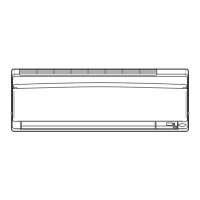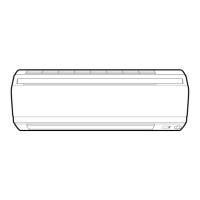What to do if water leaks from the indoor unit of Daikin Air conditioning?
- SSydney BrownAug 26, 2025
If water leaks from the indoor unit, turn the breaker OFF and call the service shop.

What to do if water leaks from the indoor unit of Daikin Air conditioning?
If water leaks from the indoor unit, turn the breaker OFF and call the service shop.
What to do if Daikin Air conditioning operation stops suddenly and the OPERATION lamp flashes?
If the Daikin air conditioning stops suddenly and the OPERATION lamp flashes, clean the air filters or remove any obstacles. Then, turn the breaker OFF, turn it ON again, and try operating the air conditioner with the remote controller.
| Cooling Capacity | 2.5 kW |
|---|---|
| Heating Capacity | 3.2 kW |
| Energy Efficiency Ratio (EER) Cooling | 3.21 |
| Weight (Indoor Unit) | 8 kg |
| Type | Split System |
| Coefficient of Performance (Heating) | 4.0 |
| Refrigerant | R32 |
| Noise Level (Indoor Unit) | 19 dB (Low) |
| Noise Level (Outdoor Unit) | 48 dB(A) |
| Power Supply | 220-240V / 50Hz |
Covers general warnings, cautions, and specific safety instructions for safe operation.
Guidelines for choosing a suitable installation location to ensure proper function and safety.
Requirements for electrical connections and procedures for safely relocating the air conditioner unit.
Identification and description of the various parts of the indoor air conditioning unit.
Identification and description of the various parts of the outdoor air conditioning unit.
Identification and description of the buttons and display of the remote controller.
Step-by-step instructions for correctly inserting batteries into the remote controller.
Guidelines for operating the remote controller and fixing its holder on a wall.
Procedure for setting the internal clock for accurate timer functions.
Steps to start/stop the unit and adjust the temperature settings for comfort.
Explanations for HEAT, COOL, DRY, and AUTO operation modes and their characteristics.
How to change the fan speed settings for different operation modes.
Instructions for controlling the direction of airflow using horizontal blades (flaps).
Instructions for manually adjusting the direction of airflow using vertical louvers.
How to activate the powerful mode for quick cooling or heating effect.
How to reduce the noise level of the outdoor unit for quiet operation.
How to record and use personalized temperature and airflow settings.
Using the motion sensor for energy saving and adjusting its detection angle.
Setting ON and OFF timers for automatic unit control.
Guidelines for operating multiple indoor units connected to one outdoor unit.
How the priority room designation affects operation and feature control.
Instructions for cleaning the indoor and outdoor unit components.
Steps for cleaning and replacing air filters and photocatalytic deodorizing filters.
Essential checks before operation and steps for preparing the unit for long-term storage.
Explains common behaviors that are not actual malfunctions.
Steps to diagnose issues and interpret fault codes.
Situations requiring professional service and critical safety warnings.
How to interpret LED lights on the outdoor unit PCB for fault diagnosis.












